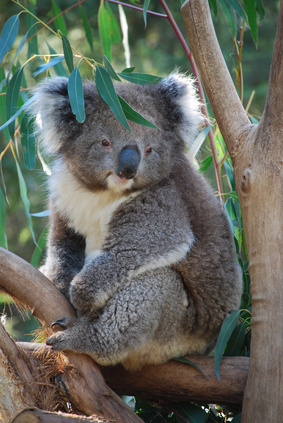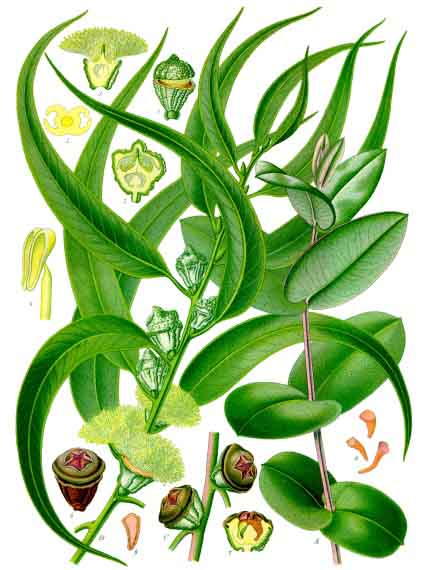
Eucalyptus globulus (Labille)
 Synonyms: blue gum, stringy bark tree,
Tasmanian blue gum
Synonyms: blue gum, stringy bark tree,
Tasmanian blue gum
Order: Myrtaceae
Description: A tall evergreen tree native to Australia and Tasmania and cultivated elsewhere. The trunk, which can grow to over 100m, is covered with peeling, papery bark. The leaves on the young plant, up to five years old, are opposite, sessile, soft, oblong, pointed and a hoary blue colour. The mature leaves are alternate, petioled, leathery and shaped like a scimitar. The flowers are solitary, axillary and white, with no petals and a woody calyx. The fruit is a hard, four-celled, many-seeded capsule enclosed in the calyx cup.
Parts used: Leaves and essential oil
Constituents: Up to 3.5% volatile oil (with up to 70% eucalyptol/cineole, plus terpineole and pinene), polyphenolic acids (including caffeic and gallic), flavonoids (including eucalyptin, hyperoside and rutin), tannins, aldehydes, bitter resin.
Actions: Antiseptic, deodorant, antispasmodic, febrifuge, expectorant, stimulant, reduces blood sugar levels, vermifuge, aromatic, secretolytic, rubefacient, decongestant
Indications: upper respiratory congestion, asthma, bronchitis
Therapeutics and Pharmacology: Eucalyptus
oil is a strong antiseptic and lozenges made from it are useful for lung diseases, colds and sore throats. Its expectorant properties are useful in
bronchitis. It can also be used as a vapour bath or chest rub for
asthma and other respiratory complaints. It is said to be useful for pyorrhoea and for burns,
where it prevents infection, and it also eradicates lice and fleas. Externally,
its antiseptic and deodorant qualities make it suitable for use on
purulent wounds and ulcers.
Diluted in sunflower oil, it can be applied to cold sores or used as a massage
oil for painful joints. A cold extract made from
the leaves is helpful for indigestion and for intermittent
 fever. In traditional
Australian Aboriginal medicine the leaves are
used in poultices for any type of wound and inflammation.
fever. In traditional
Australian Aboriginal medicine the leaves are
used in poultices for any type of wound and inflammation.
Combinations: May be combined with Rosmarinus oil in a massage oil base for rheumatic and arthritic pain.
Caution: In large doses the oil is irritant to the kidneys, and it should not be taken internally, other than in proprietary lozenges.
Preparation and Dosage:
Regulatory Status: GSL
External use only, unless under medical advice
Additional Comments: A traditional Aboriginal fever remedy, Eucalyptus was introduced to the West in the 19th century by the director of the Melbourne Botanical Gardens, and cultivation of the tree spread in southern Europe and North America. The properties of oils from different species vary slightly, but all are very antiseptic. Other species used for oil production include E.polybracteata and E. smithii, Russian research suggests that some species counteract influenza viruses; others are antimalarial or highly bactericidal. The tree's amazing ability to dry out marshy soil led to its use in eradicating the malaria mosquito in many parts of the world.
Bibliography
Grieve, M. 1931 A Modern Herbal, (ed. C.F. Leyel 1985), London.
Lust, J. 1990 The Herb Book, Bantam, London.
Mabey, R. (ed.) 1991 The Complete New Herbal, Penguin, London.
Moore, M. 1989 Medicinal Plants of the Desert and Canyon West, Museum of New Mexico Press, Santa Fe.
Ody, P. 1993 The Herb Society's Complete Medicinal Herbal, Dorling Kindersley, London.
Polunin, M. and Robbins, C. 1992 The Natural Pharmacy, Dorling Kindersley, London.
Weiss, R.F. 1991 Herbal Medicine, Beaconsfield Arcanum, Beaconsfield.
Wren, R.C. 1988 Potter's New Cyclopaedia of Botanical Drugs and Preparations, C.W.Daniel, Saffron Walden.










